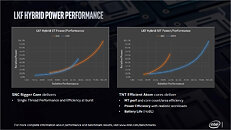- Joined
- Oct 9, 2007
- Messages
- 47,528 (7.48/day)
- Location
- Hyderabad, India
| System Name | RBMK-1000 |
|---|---|
| Processor | AMD Ryzen 7 5700G |
| Motherboard | ASUS ROG Strix B450-E Gaming |
| Cooling | DeepCool Gammax L240 V2 |
| Memory | 2x 8GB G.Skill Sniper X |
| Video Card(s) | Palit GeForce RTX 2080 SUPER GameRock |
| Storage | Western Digital Black NVMe 512GB |
| Display(s) | BenQ 1440p 60 Hz 27-inch |
| Case | Corsair Carbide 100R |
| Audio Device(s) | ASUS SupremeFX S1220A |
| Power Supply | Cooler Master MWE Gold 650W |
| Mouse | ASUS ROG Strix Impact |
| Keyboard | Gamdias Hermes E2 |
| Software | Windows 11 Pro |
A performance review of the Intel Core i5-L16G7 "Lakefield" Hybrid processor (powering a Samsung Galaxy S notebook) was recently published by Golem.de, which provides an in-depth look at Intel's ambitious new processor design that sets in motion the two new philosophies Intel will build its future processors on - packaging modularity provided by innovative new chip packaging technologies such as Foveros; and Hybrid processing, where there are two sets of CPU cores with vastly different microarchitectures and significantly different performance/Watt curves that let the processor respond to different kinds of workloads while keeping power-draw low. This concept was commercially proliferated first by Arm, with its big.LITTLE topology that took to the market around 2013. The "Lakefield" i5-L16G7 combines a high-performance "Sunny Cove" CPU core with four smaller "Tremont" cores, and Gen11 iGPU.
The Golem.de report reveals that Windows 10 thread scheduler is aware of the hybrid multi-core topology of "Lakefield," and that it is able to classify workloads at a very advanced level so the right kind of core is in use at any given time. The "Sunny Cove" core is called upon when interactive vast serial processing loads are in demand. This could even be something like launching applications, new tabs in a multi-process web-browser, or less-parallelized media encoding. The four "Tremont" cores keep the machine "cruising," handling much of the operational workload of an application, and is also better tuned to cope with highly parallelized workloads. This is similar to a hybrid automobile, where the combustion engine provides tractive effort from 0 kph, while the electric motor sustains a cruising speed.




The Core i5-L16G7 has a rated SDP (scenario driven power) rating of 7 W. The package PL1 value is 7 W, too. Intel also gave the chip a PL2 value of 9.5 W, and a Tau value of 28 seconds. Some notebook vendors, however, are expected to set PL1 at 5 W. Raising it to 7 W will only be possible through a UEFI firmware update. Throughout Golem's testing, they observed that the "Sunny Cove" core kicks in during interactive workloads that require burst performance from the CPU, with the core typically clocked at 2.50 GHz, occasionally hitting 2.90 GHz. The smaller "Tremont" cores are typically clocked at 1.90 GHz during workloads, and can boost up to 2.70 GHz.
Perhaps the biggest dividend of topology-awareness by Windows OS scheduler is with the core rotation policy. By default, the Windows scheduler spreads a single-threaded workload across multiple cores (in sequence). AMD had to work with Microsoft to make Windows aware of the topology of its multi-CCX Ryzen processors, so workloads aren't spread between two CCX's if they don't have to. Similarly with "Lakefield," core rotation is localized to the "Tremont" cores.
Golem outlined the performance equation between the single "Sunny Cove" core and the four "Tremont" cores. A single "Sunny Cove" core has anywhere between 25-65% higher performance than a single "Tremont" core. On the other hand, the entire block of 4 "Tremont" cores offer 2x the performance of a single "Sunny Cove" core. This lends the two core blocks very different performance and power characteristics.



The Core i5-L16G7 tests consistently ahead of the Qualcomm Snapdragon 8xC 8-core (4 big+4LITTLE) processor that has the same 7 W TDP. Golem tested the processor across 25 tests, comparing it with i7-1065G7 ICL-U 15 W, an i5-10210U "Comet Lake-U" 15 W processor, and a Pentium Silver N5000 SoC that has just "Tremont" cores. Raising the power limits appears to increase performance of the i5-L16G7 by anywhere between 40-60%.


Much of what Intel learns from "Lakefield" will be implemented in future client-segment architectures such as "Meteor Lake," which will combine larger hybrid CPU core arrays to achieve high core counts. The i5-L16G7 allows notebook designers to make ultra portable devices with the power envelope of Snapdragon, but with the benefits of x86.
Find more benchmark results and commentary in the source link below.
View at TechPowerUp Main Site
The Golem.de report reveals that Windows 10 thread scheduler is aware of the hybrid multi-core topology of "Lakefield," and that it is able to classify workloads at a very advanced level so the right kind of core is in use at any given time. The "Sunny Cove" core is called upon when interactive vast serial processing loads are in demand. This could even be something like launching applications, new tabs in a multi-process web-browser, or less-parallelized media encoding. The four "Tremont" cores keep the machine "cruising," handling much of the operational workload of an application, and is also better tuned to cope with highly parallelized workloads. This is similar to a hybrid automobile, where the combustion engine provides tractive effort from 0 kph, while the electric motor sustains a cruising speed.




The Core i5-L16G7 has a rated SDP (scenario driven power) rating of 7 W. The package PL1 value is 7 W, too. Intel also gave the chip a PL2 value of 9.5 W, and a Tau value of 28 seconds. Some notebook vendors, however, are expected to set PL1 at 5 W. Raising it to 7 W will only be possible through a UEFI firmware update. Throughout Golem's testing, they observed that the "Sunny Cove" core kicks in during interactive workloads that require burst performance from the CPU, with the core typically clocked at 2.50 GHz, occasionally hitting 2.90 GHz. The smaller "Tremont" cores are typically clocked at 1.90 GHz during workloads, and can boost up to 2.70 GHz.
Perhaps the biggest dividend of topology-awareness by Windows OS scheduler is with the core rotation policy. By default, the Windows scheduler spreads a single-threaded workload across multiple cores (in sequence). AMD had to work with Microsoft to make Windows aware of the topology of its multi-CCX Ryzen processors, so workloads aren't spread between two CCX's if they don't have to. Similarly with "Lakefield," core rotation is localized to the "Tremont" cores.
Golem outlined the performance equation between the single "Sunny Cove" core and the four "Tremont" cores. A single "Sunny Cove" core has anywhere between 25-65% higher performance than a single "Tremont" core. On the other hand, the entire block of 4 "Tremont" cores offer 2x the performance of a single "Sunny Cove" core. This lends the two core blocks very different performance and power characteristics.



The Core i5-L16G7 tests consistently ahead of the Qualcomm Snapdragon 8xC 8-core (4 big+4LITTLE) processor that has the same 7 W TDP. Golem tested the processor across 25 tests, comparing it with i7-1065G7 ICL-U 15 W, an i5-10210U "Comet Lake-U" 15 W processor, and a Pentium Silver N5000 SoC that has just "Tremont" cores. Raising the power limits appears to increase performance of the i5-L16G7 by anywhere between 40-60%.


Much of what Intel learns from "Lakefield" will be implemented in future client-segment architectures such as "Meteor Lake," which will combine larger hybrid CPU core arrays to achieve high core counts. The i5-L16G7 allows notebook designers to make ultra portable devices with the power envelope of Snapdragon, but with the benefits of x86.
Find more benchmark results and commentary in the source link below.
View at TechPowerUp Main Site








